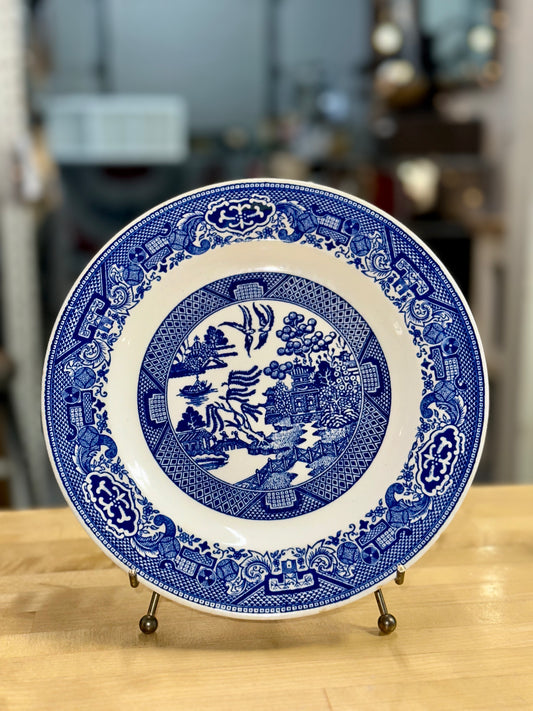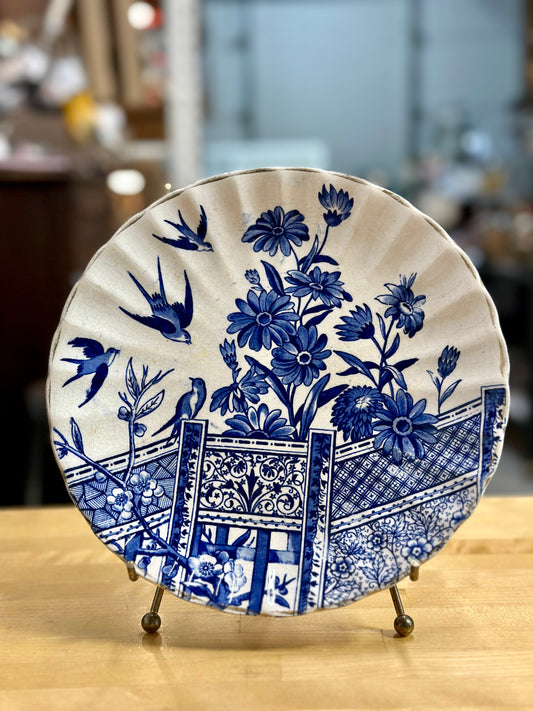Collection: Blue Willow
Blue Willow, despite its name, did not originate in China but rather was born out of the creative ingenuity of Thomas Turner in 18th century England. Hailing from Caughley, Shropshire, Turner forged a reputation for himself as a specialist in Chinese patterns. In 1779, he enlisted the skills of Thomas Minton, who went on to become a renowned potter in his own right, to engrave the original Willow pattern. It is worth noting that Minton began his pottery career as an apprentice under Turner before later working with Josiah Spode. The Willow pattern itself drew inspiration from a Chinese blue and white landscape pattern known as Nanking, adding a touch of exotic allure to this English creation.
Interestingly, the story associated with Blue Willow was not of Chinese origin either. It was, in fact, a marketing ploy devised by Turner to further enhance the appeal of the pattern. By the end of the 18th century, Blue Willow had gained such popularity throughout Europe that multiple English potteries began producing their own versions of the pattern, solidifying its place in the world of ceramics.
The Blue Willow pattern boasts an impressive production span of over 200 years, with as many as 500 different manufacturers contributing to its rich history. As a result, there are numerous variations of the pattern in existence. However, it is essential to note that certain elements must be present in order for a piece to be classified as genuine Blue Willow. These elements include the iconic fence, bridge, doves, stream, and, of course, the willow tree. Without these components, the pattern cannot be considered true Blue Willow.
Blue Willow is a prime example of transferware, a technique involving the use of an engraved copper-plate pressed onto paper, which is then transferred to the pottery. While transferware is primarily associated with earthenware, Blue Willow can also be found on porcelain, ironstone, and bone china. The pattern's distinct color palette encompasses shades of blue, red (pink), green, brown, black, and mulberry (purple), which contribute to its timeless and captivating aesthetic.
When it comes to determining the authenticity and age of Blue Willow pieces, maker's marks are often key indicators. However, it is unfortunate that not all Blue Willow items bear these marks, particularly early pieces. In such cases, experts and collectors often rely on other clues to date these pieces accurately. Factors such as the body type, glaze, and the pattern itself can provide valuable insights into their age. Early Blue Willow items are often characterized by a softer glaze and may exhibit evidence of crazing, adding a touch of charm and authenticity to these vintage pieces.
American production of Blue Willow did not commence until 1905 when the Buffalo Pottery Company introduced the pattern to the United States, marking a significant milestone in the pattern's journey.
Blue Willow's journey spans across centuries and continents, captivating individuals with its intriguing blend of English craftsmanship and Chinese inspiration. Its enduring popularity and multitude of variations serve as a testament to its timeless and enchanting appeal. Whether labeled as Chinese or English, Blue Willow is a cherished pattern that continues to captivate collectors and enthusiasts around the world.
-
Thanksgiving turkey plate produced by Enoch Wood & Sons
Regular price $30.00 USDRegular priceUnit price / per -
Ridgway Oriental Blue and White Transferware Plate
Regular price $25.00 USDRegular priceUnit price / per -
Blue Willow - Buffalo Pottery
Regular price From $20.00 USDRegular priceUnit price / perBlue Willow - Buffalo Pottery
Regular price From $20.00 USDRegular priceUnit price / perBlue Willow - Buffalo Pottery
Regular price From $20.00 USDRegular priceUnit price / per -
RH and Co Blue Transferware Singanese Plates
Regular price $30.00 USDRegular priceUnit price / per -
Exquisite Vintage Blue Willow Ware Plates - a Timeless Collectible
Regular price $25.00 USDRegular priceUnit price / per -
Antique BH & PS Swallow Blue Transferware plates
Regular price $20.00 USDRegular priceUnit price / per -
Ridgway Blue Willow Semi-China
Regular price From $35.00 USDRegular priceUnit price / perRidgway Blue Willow Semi-China
Regular price From $35.00 USDRegular priceUnit price / perRidgway Blue Willow Semi-China
Regular price From $35.00 USDRegular priceUnit price / per -
Vintage Blue Transferware Made in Occupied Japan
Regular price $15.00 USDRegular priceUnit price / perVintage Blue Transferware Made in Occupied Japan
Regular price $15.00 USDRegular priceUnit price / perVintage Blue Transferware Made in Occupied Japan
Regular price $15.00 USDRegular priceUnit price / per -
Blue Willow - Staffordshire Pottery
Regular price From $17.00 USDRegular priceUnit price / perBlue Willow - Staffordshire Pottery
Regular price From $17.00 USDRegular priceUnit price / perBlue Willow - Staffordshire Pottery
Regular price From $17.00 USDRegular priceUnit price / per -
Vintage willow johnson brothers england set of 2 tea cups w/inside imprint transferware
Regular price $25.00 USDRegular priceUnit price / per -
Vintage Willow Johnson Brothers 12 1/4” Oval Serving Platter
Regular price $38.00 USDRegular priceUnit price / per -
Vintage Blue Willow Johnson Brother’s England Sugar Bowl
Regular price $25.00 USDRegular priceUnit price / per -
Vintage Blue Willow Johnson Brother’s England Dinner Plates 10”- Set of 7
Regular price $90.00 USDRegular priceUnit price / per -
Allertons of England Blue Willow
Regular price From $20.00 USDRegular priceUnit price / perAllertons of England Blue Willow
Regular price From $20.00 USDRegular priceUnit price / perAllertons of England Blue Willow
Regular price From $20.00 USDRegular priceUnit price / per















